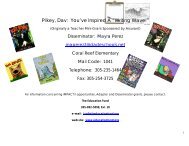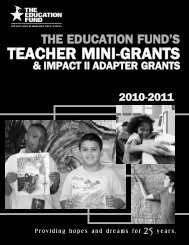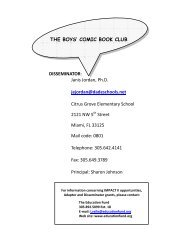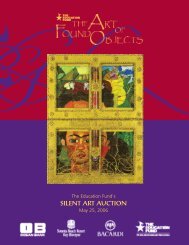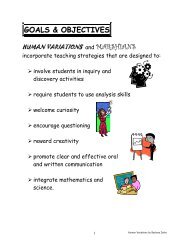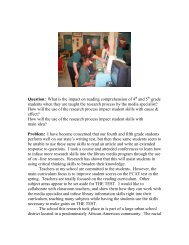Found Figurative Language by Terri Sabbag - The Education Fund
Found Figurative Language by Terri Sabbag - The Education Fund
Found Figurative Language by Terri Sabbag - The Education Fund
You also want an ePaper? Increase the reach of your titles
YUMPU automatically turns print PDFs into web optimized ePapers that Google loves.
Course Overview<br />
<strong>Figurative</strong> language helps to create imaginative and detailed writing. <strong>The</strong>re can never<br />
be too many examples of figurative language, particularly when one is a fourth grade<br />
teacher instructing children on identifying figurative language, and then creating and<br />
incorporating it in their own writing.<br />
I began the figurative language unit with my fourth grade class <strong>by</strong> familiarizing students<br />
with the different facets of figurative language. I have various posters and charts that I<br />
have made and have bought with definitions and examples of figurative language<br />
hanging on the walls in my classroom. From the first day, I encouraged the students to<br />
find examples of personification in their independent reading. Subsequently, they<br />
searched for similes, metaphors, hyperbole, and onomatopoeia. As we read poetry,<br />
trade books, and non-fiction books and articles, I pointed out various examples. I then<br />
distributed Post-it notes for students to mark the pages in their books each time they<br />
found figurative language. We shared their findings aloud with the class on a daily<br />
basis.<br />
Once students started hunting for similes, metaphors, personification, etc. on their own,<br />
they were soon “flooding” me each morning with examples. <strong>Figurative</strong> language<br />
appeared all day long, in all aspects of their reading. With so many examples pouring<br />
in, I decided they should be displayed; so, I provided students with index cards for them<br />
to record their examples, which I subsequently tacked on a bulletin board.<br />
One morning, two of my students handed me a large stack of index cards. I remarked<br />
that they were quickly developing into the “queens” of figurative language and that we<br />
needed a crown. Immediately, one of the girls volunteered to make one, and the very<br />
next day, a plastic, jeweled tiara arrived. <strong>The</strong> students and I then decided that the boy<br />
who provided the most figurative language would be crowned “king” and that he should<br />
carry a scepter. Again, an eager student volunteered his artist-mother to create a staff.<br />
Queen FL (figurative language) and King Scribe were born. We then decorated an old<br />
jewelry box where students could place their figurative language “treasures,” which<br />
were read aloud daily and displayed.<br />
My fourth grade students nominated the King and Queen, based on either the number<br />
of examples the students turned in or the richest examples found.<br />
Displaying student examples on a bulletin board provided: (1) a daily incentive for<br />
students to find their own FL for display; (2) an opportunity to be exposed to a plethora<br />
of figurative language examples: and (3) opportunities to get recommendations from<br />
peers for books rich in figurative language.<br />
<strong>The</strong> students took great delight in this incentive to find writing treasures and to share<br />
them with the class. Each Queen FL and King Scribe proudly wore/carried their royal<br />
finery on the day they were crowned<br />
Page 4 of 18







